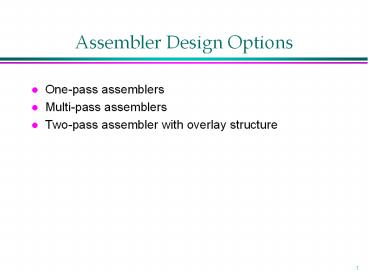Assembler Design Options - PowerPoint PPT Presentation
1 / 17
Title:
Assembler Design Options
Description:
Both one-pass and two-pass assemblers can be designed as load-and-go. ... For a load-and-go assembler, the actual address must be known at assembly time, ... – PowerPoint PPT presentation
Number of Views:1233
Avg rating:5.0/5.0
Title: Assembler Design Options
1
Assembler Design Options
- One-pass assemblers
- Multi-pass assemblers
- Two-pass assembler with overlay structure
2
Two-Pass Assembler with Overlay Structure
- For small memory
- pass 1 and pass 2 are never required at the same
time - three segments
- root driver program and shared tables and
subroutines - pass 1
- pass 2
- tree structure
- overlay program
3
One-Pass Assemblers
- Main problem
- forward references
- data items
- labels on instructions
- Solution
- data items require all such areas be defined
before they are referenced - labels on instructions no good solution
4
One-Pass Assemblers
- Main Problem
- forward reference
- data items
- labels on instructions
- Two types of one-pass assembler
- load-and-go
- produces object code directly in memory for
immediate execution - the other
- produces usual kind of object code for later
execution
5
Load-and-go Assembler
- Characteristics
- Useful for program development and testing
- Avoids the overhead of writing the object program
out and reading it back - Both one-pass and two-pass assemblers can be
designed as load-and-go. - However one-pass also avoids the over head of an
additional pass over the source program - For a load-and-go assembler, the actual address
must be known at assembly time, we can use an
absolute program
6
Forward Reference in One-pass Assembler
- For any symbol that has not yet been defined
- 1. omit the address translation
- 2. insert the symbol into SYMTAB, and mark this
symbol undefined - 3. the address that refers to the undefined
symbol is added to a list of forward references
associated with the symbol table entry - 4. when the definition for a symbol is
encountered, the proper address for the symbol is
then inserted into any instructions previous
generated according to the forward reference list
7
Load-and-go Assembler (Cont.)
- At the end of the program
- any SYMTAB entries that are still marked with
indicate undefined symbols - search SYMTAB for the symbol named in the END
statement and jump to this location to begin
execution - The actual starting address must be specified at
assembly time - Example
- Figure 2.18, 2.19
8
Producing Object Code
- When external working-storage devices are not
available or too slow (for the intermediate file
between the two passes - Solution
- When definition of a symbol is encountered, the
assembler must generate another Tex record with
the correct operand address - The loader is used to complete forward references
that could not be handled by the assembler - The object program records must be kept in their
original order when they are presented to the
loader - Example Figure 2.20
9
Multi-Pass Assemblers
- Restriction on EQU and ORG
- no forward reference, since symbols value cant
be defined during the first pass - Example
- Use link list to keep track of whose value depend
on an undefined symbol - Figure 2.21
10
Implementation Examples
- Microsoft MASM Assembler
- Sun Sparc Assembler
- IBM AIX Assembler
11
Microsoft MASM Assembler
- SEGMENT
- a collection segments, each segment is defined as
belonging to a particular class, CODE, DATA,
CONST, STACK - registers CS (code), SS (stack), DS (data), ES,
FS, GS - similar to program blocks in SIC
- ASSUME
- e.g. ASSUME ESDATASEG2
- e.g. MOVE AX, DATASEG2
- MOVE ES,AX
- similar to BASE in SIC
12
Microsoft MASM Assembler
- JUMP with forward reference
- near jump 2 or 3 bytes
- far jump 5 bytes
- e.g. JMP TARGET
- Warning JMP FAR PTR TARGET
- Warning JMP SHORT TARGET
- Pass 1 reserves 3 bytes for jump instruction
- phase error
- PUBLIC, EXTRN
- similar to EXTDEF, EXTREF in SIC
13
Sun Sparc Assembler
- Sections
- .TEXT, .DATA, .RODATA, .BSS
- Symbols
- global vs. weak
- similar to the combination of EXTDEF and EXTREF
in SIC - Delayed branches
- delayed slots
- annulled branch instruction
14
Sun Sparc Assembler
- LOOP .
- .
- ADD L2, L3, L4
- CMP L0, 10
- BLE LOOP
- .
LOOP . . . ADD L2,
L3, L4 CMP L0, 10 BLE LOOP
NOP
- .
- .
- CMP L0, 10
- BLE LOOP
- ADD L2, L3, L4
- .
15
Sun Sparc Assembler
- LOOP ADD L2, L3, L4
- .
- .
- CMP L0, 10
- BLE,A LOOP
- .
LOOP . . . CMP L0,
10 BLE,A LOOP ADD L2,
L3, L4
16
AIX Assembler for PowerPC
- Similar to System/370
- Base relative addressing
- save instruction space, no absolute address
- base register table
- general purpose registers can be used as base
register - easy for program relocation
- only data whose values are to be actual address
needs to be modified - e.g. USING LENGTH, 1
- USING BUFFER, 4
- Similar to BASE in SIC
- DROP
17
AIX Assembler for PowerPC
- Alignment
- instruction (2)
- data halfword operand (2), fullword operand (4)
- Slack bytes
- .CSECT
- control sections RO(read-only data),
RW(read-write data), PR(executable instructions),
BS(uninitialized read/write data) - dummy section

